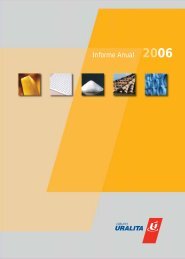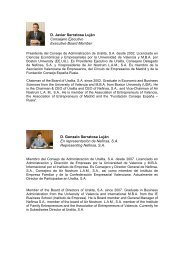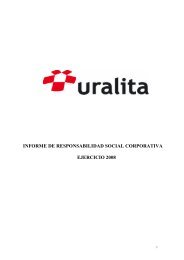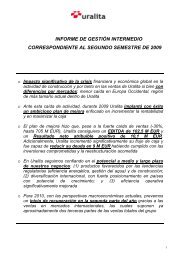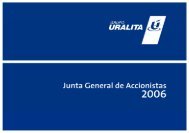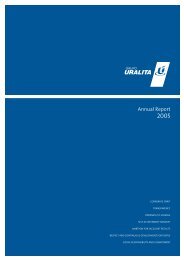Financial Information - Uralita
Financial Information - Uralita
Financial Information - Uralita
You also want an ePaper? Increase the reach of your titles
YUMPU automatically turns print PDFs into web optimized ePapers that Google loves.
FINANCIAL INFORMATION ANNUAL REPORT 2006<br />
the basis of the warehouse materials consumed<br />
in-house and manufacturing costs incurred).<br />
Property, plant and equipment are depreciated<br />
on a straight-line basis at annual rates based on<br />
the years of estimated useful life of the related<br />
assets. The rates used are the following:<br />
Buildings<br />
Plant<br />
Machinery<br />
Tools<br />
Furniture and fittings<br />
Data processing equipment<br />
Transport equipment<br />
Land is considered to have an indefinite useful<br />
life and therefore is not depreciated.<br />
4.4. Non-current assets held for sale<br />
YEARS OF ESTIMATED<br />
USEFUL LIFE<br />
33 / 50<br />
10 / 20<br />
10 / 20<br />
5 / 8<br />
10 / 15<br />
4<br />
6 / 7<br />
Non-current assets classified as held for sale are<br />
carried at the lower of carrying amount and fair<br />
value less costs to sell.<br />
An item is classified as held for sale if its<br />
carrying amount will be recovered principally<br />
through a sale transaction rather than through<br />
continuing use. This condition is deemed to<br />
have been met only when disposal is highly<br />
probable and the asset is available for immediate<br />
sale in its current state, and the sale is expected<br />
to be concluded within one year from the date of<br />
classification.<br />
4.5. Impairment of property, plant and<br />
equipment and intangible assets<br />
excluding goodwill<br />
At each balance sheet date, the Group reviews<br />
the carrying values of its property, plant and<br />
equipment and intangible assets to determine if<br />
there are indications that the assets have been<br />
impaired. If there are indications of impairment,<br />
the recoverable amount of the assets is<br />
calculated to determine any potential impairment<br />
loss. Where the asset does not generate cash<br />
inflows that are independent of those from other<br />
assets, the Group estimates the recoverability of<br />
the cash-generating unit to which the asset<br />
belongs.<br />
An asset’s recoverable amount is the higher of<br />
its fair value less costs to sell and value in use.<br />
In assessing value in use, the estimated future<br />
cash flows are discounted to their present value<br />
using a pre-tax discount rate that reflects current<br />
market assessment of the time value of money<br />
and the risks specific to the asset for which the<br />
future cash flow estimates have not been<br />
adjusted.<br />
Where the carrying amount exceeds the<br />
recoverable amount of an asset (or cashgenerating<br />
unit), the asset (or cash-generating<br />
unit) is written down to its recoverable amount.<br />
An impairment loss is immediately recognized as<br />
an expense, except where the asset is stated at<br />
revalued cost, in which case the impairment loss<br />
is recognized as a decrease to the revaluation<br />
reserve.<br />
When an impairment loss is subsequently<br />
reversed, the carrying amount of the assets<br />
143



